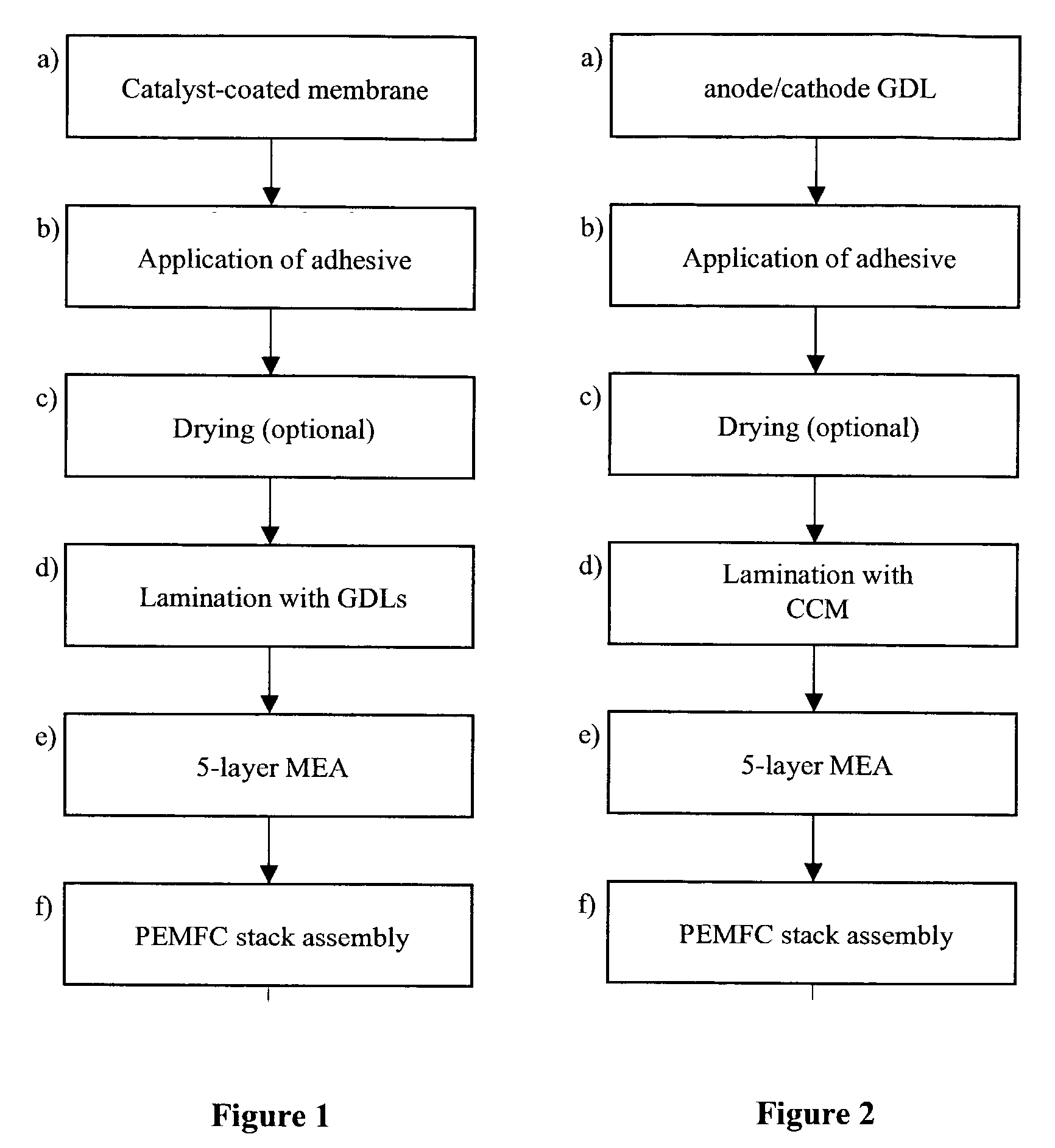Process for the manufacture of membrane-electrode-assemblies using catalyst-coated membranes
a technology of catalyst-coated membranes and assembly processes, which is applied in the direction of fuel cells, coatings, cells, etc., can solve the problems of low catalyst utilisation, the need to separate assembly of catalyst-coated membranes, and the damage or perforation of membranes, so as to simplify the assembly of products into pemfc and dmfc stacks and improve the performance of five-layer meas
- Summary
- Abstract
- Description
- Claims
- Application Information
AI Technical Summary
Benefits of technology
Problems solved by technology
Method used
Image
Examples
example 1
[0041] A catalyst-coated membrane (CCM Type R221, reformate operation / full humidification, active area 50 cm.sup.2; OMG AG & Co. KG, Hanau) was used as the CCM component. The anode electrode side contained a PtRu / C electrocatalyst and had a total precious metal loading of 0.45 mg (0.3 mg Pt / cm.sup.2 and 0.15 mg Ru / cm.sup.2), the cathode side contained a Pt / C electrocatalyst with a Pt loading of 0.4 mg Pt / cm.sup.2.
[0042] The anode GDL, hereinafter referred to as GDL(A), was prepared as follows: A sheet of carbon fiber paper (thickness 350 .mu.m, porosity 85%; supplied by SGL Carbon Group, type SIGRACET.RTM.) was wet proofed with a water based PTFE solution (type Hostaflon TF 5032, Dyneon.RTM.g, Gendorf) to a PTFE content of 16 wt. % and a microlayer, consisting of carbon black and PTFE was applied to one side of the carbon paper by screen printing. The cathode GDL, hereinafter referred to as GDL(C), was prepared accordingly, however, the PTFE content was reduced to 9 wt. % in the wet...
example 2
[0045] A catalyst-coated membrane (CCM Type R221, active area 50 cm.sup.2; OMG AG & Co. KG) was used as the CCM component. GDL(A) and GDL(C) were prepared as described in example 1. A catalyst-containing paste was formulated according to the following composition:
1 15.0 g Electrocatalyst Elyst .TM. A 40 (OMG AG, Hanau) 50.0 g Nafion .RTM. SE 10072 (10 wt. % in water, DuPont) 35.0 g Dipropylene glycol 100.0 g
[0046] The catalyst-containing paste was applied in a fine dot pattern onto the anode side of the active area of the CCM. The diameter of the dots was 1 mm, an automatic dispenser unit with a needle of 0.5 mm diameter was used. In a second step, the same amount of catalyst-containing paste was applied onto the microlayer-coated side of the cathode backing GDL(C). After drying at 80.degree. C. for 2 minutes, the CCM was sandwiched between anode GDL(A) and cathode GDL(C). This assembly was subsequently hot pressed at 120.degree. C. at a pressure of 8 bar. A flexible five-layer MEA ...
example 3
[0047] A catalyst-coated membrane (CCM Type R221, active area 50 cm.sup.2; OMG AG & Co. KG) was used. Anode and cathode GDLs were prepared as described in example 1. A carbon black-containing adhesive paste was prepared with the following composition:
2 20.0 g Carbon Black Shawinigan (Chevron) 60.0 g Nafion .RTM. SE 10072 (10 wt. % in water, DuPont) 20.0 g Dipropylene glycol 100.0 g
[0048] The carbon black-containing adhesive paste was selectively screen printed onto the microlayer-coated side of the anode and the cathode GDLs. The drying step was omitted. The further processing was as described in example 2. A five-layer MEA with very good electrical performance was obtained (Table 1)
[0049] Electrochemical Testing
[0050] The five-layer MEAs were tested in a PEMFC single cell with an active area of 50 cm.sup.2 running on reformate / air conditions with simulated natural gas reformate (composition 40 vol.-% hydrogen, 40 vol.-% nitrogen, 20 vol.-% carbon dioxide, 40 ppm carbon monoxide and...
PUM
| Property | Measurement | Unit |
|---|---|---|
| temperature | aaaaa | aaaaa |
| temperature | aaaaa | aaaaa |
| pressure | aaaaa | aaaaa |
Abstract
Description
Claims
Application Information
 Login to View More
Login to View More - R&D
- Intellectual Property
- Life Sciences
- Materials
- Tech Scout
- Unparalleled Data Quality
- Higher Quality Content
- 60% Fewer Hallucinations
Browse by: Latest US Patents, China's latest patents, Technical Efficacy Thesaurus, Application Domain, Technology Topic, Popular Technical Reports.
© 2025 PatSnap. All rights reserved.Legal|Privacy policy|Modern Slavery Act Transparency Statement|Sitemap|About US| Contact US: help@patsnap.com


